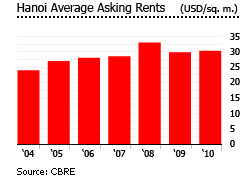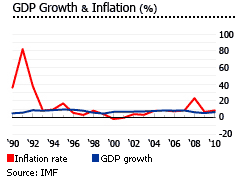Weak Dong could hit Vietnam's real estate market
Vietnam’s real estate prices have risen this past year, but a number of factors have recently brought uncertainty to the market .
The first factor has been falling US dollar reserves and the weakening Vietnamese dong (VND), due to high inflation.
Due to the managed-float exchange rate regime, dollar reserves are quickly drying up as the government, under pressure from double-digit inflation, sells foreign currencies to keep the exchange rate within a band. The currency is depreciating, and as it falls further, more people want to convert their money into dollars or gold. This has serious repercussions for the housing market, because most real estate transactions are quoted and concluded in US dollars. If the supply of dollars dries up, the real estate market could grind to a halt.

Hyperinflation in the late 1980s to early 1990s led to the use of gold, measured in taels, for house purchases. Without the use of gold or US dollars, sacks of paper bills would have been needed to purchase a small house or pay rent.
With gold prices rapidly rising in the mid 2000s, the real estate market was at a standstill until the shift to US dollars. Many real estate developers set-up their prices in US dollars to ensure that their profits are not affected by exchange rate fluctuations. Thus, exchange rate-related risks are passed on to homebuyers. Even 100% Vietnamese-invested residential developments post prices and require payment in US dollars.
Decree 71
The second issue was last August’s implementation of Decree 71/2001/ND-CP (Decree 71), providing guidance on the November 2005 Law on Residential Housing. Decree 71 aims to discourage speculative real estate investment. Intended to minimise risks for buyers, Decree 71 requires clearance from the Prime Minister for large-scale developments.
Uncertainty over the implementation of Decree 71 caused developers to accelerate construction of some projects and the purchase of lands, lead to huge price spikes in some areas, while flooding other areas with new supply.
In HCMC, Vietnam’s economic center, residential resale prices in all segments have been steady for the past two years, according to CB Richard Ellis Vietnam.
- In the low-end market, the average asking price was US$726 per sq.m. in Q3 2010
- In the high-end segment, the average asking price was US$1,898 per sq. m. in Q3 2010
On the other hand, Hanoi residential resale prices were up 9% on average during the year to Q3 2010, at US$1,837 per sq. m.
- In the low-end segment, average asking prices jumped 24% y-o-y to Q3 2010, but were up a mere 2.2% from the previous quarter.
- Prices in the luxury and high-end segment fell 1% during the quarter to Q3 2010.
AVERAGE ASKING PRICE (Q3 2010) |
|||
| Hanoi Secondary Market | US$ per sq. m. | q-o-q change (%) | y-o-y change (%) |
| Luxury segment | 3,009 | -0.16 | 2.33 |
| High-end segment | 1,924 | -0.61 | 9.75 |
| Mid-end segment | 1,349 | 1.37 | 15.1 |
| Low-end segment | 977 | 2.21 | 24.09 |
| Total | 1,837 | 0.29 | 9.02 |
| Source:CB Richard Ellis Vietnam | |||
In the third quarter of 2010, the average price of villas located in posh residential areas in Vietnam range from US$1.5 million to US$2 million while villas in new neighbourhoods are priced at US$250,000, according to local real estate analysts.
Under the Ordinance on Foreign Exchange Management, all transactions done in Vietnam must be in VND. However, most real estate projects, especially luxury villas and apartments, are quoted in US dollars. These include projects like:
- Keangnam Landmark Tower, at US$2,800 to US$3,300 per sq. m.
- Indochina Plaza Hanoi, at US$2,800 per sq. m.
- Sky City Tower, at US$2,300 per sq. m.
- Mulbery Lane, at US$1,800 per sq. m.
- Parkcity, at US$3,000 per sq. m.
- Usilk urban area project, at US$1,000 to US$2,000 per sq. m.
- Mipec Tower, at US$1,000 to US$2,000 per sq. m.
- Thanh Cong Tower, at US$1,000 to US$2,000 per sq. m.
- 302 Cau Giay street project, at US$1,000 to US$2,000 per sq. m.
Viet Kieus can now buy unlimited property, just like resident Vietnamese
Decree 71 also contains revisions to the Housing Law allowing Viet Kieu (overseas Vietnamese) to possess as unlimited property just like Vietnamese citizens. The new regulations are expected to create more demand in the housing market. About 70% of the 4 million Viet Kieu retain their Vietnamese nationality, according to the Ministry of Construction.
In addition, even if a Viet Kieu has given up his Vietnamese nationality, he is still given the same homeownership right, provided that:
- He has invested under the Law of Investment
- He is married to a Vietnamese citizen living in the country
- He is working in Vietnam as a cultural activist, scientist or has special skills and he has made contributions to the country
Before the new decree took effect, Decree 81, already in force, allowed certain Viet Kieu to buy property. However after 9 years of implementation, only 140 Viet Kieu had bought houses in their own names, due to red tape.
It is however unclear if the new decree will address the problems of corruption and red tape. In addition, many overseas Vietnamese prefer to purchase property under the names of relatives to avoid tax liabilities and other obligations.
Decree 71 also mandates that residential housing projects with a total of 2,500 housing units (incl. villas, detached houses, apartment buildings, new urban zones and mixed use projects) must be approved by the Prime Minister. Any amendments to the project must also be approved by the Prime Minister. This can potentially lead to delays and more red tape.
Perpetual Lease
In theory, freehold land does not exist in Vietnam. Land can only be leased, even by Vietnamese; though in reality many leases seem to be for indefinite terms. “Buying” land is technically a transfer of leasing rights. The creation of a perpetually renewable lease means that Vietnam now has one of the most open property markets in Asia.
However, the 70 years lease period allowed to foreign investors was reduced to 50 years in 2009.
Under-served low-end market
Demand for affordable housing has risen in recent years, given a rising population, rapid migration from rural to urban areas, and rapidly improving living standards. The demand for affordable houses is now outstripping supply, as residential development has largely focused on high-end customers.
According to RNCOS, a global market research company, many Vietnamese do not have their own houses and more than 70% of households live in temporary wooden houses. RNCOS estimates that Vietnam is deficient of about 20 million permanent housing units.
In Ho Chi Minh City, the country’s largest city, only 14% of the total supply of luxury apartments was sold in the first eight months of 2010, according to a survey conducted by Cushman and Wakefield Vietnam.
On the other hand, about 670 units of newly-built apartments in Hanoi were sold in the 2nd quarter of 2010, or about 48% of the supply in the primary market in the capital, according to Savills Vietnam, a UK-based research firm.
vietnamese and overseas Vietnamese account for about 70% of homebuyers in the country, while the rest are foreigners, according to Nguyen Kim Son of BTA Development Investment.
Supply increases
In the 3rd quarter of 2010, the total supply of condominium units in Hanoi was 75,235 units, up 4.5% from the previous quarter, according to CB Richard Ellis Vietnam. In addition, about 3,000 additional units are expected to be completed in Hanoi in the last quarter of 2010.
TOTAL SUPPLY OF CONDOMINIUM UNITS (HANOI) |
|||
| Q2 2010 | Q3 2010 | Q-O-Q CHANGE (%) | |
| Luxury segment | 2,186 | 2,186 | - |
| High-end segment | 12,709 | 14,005 | 10.2 |
| Mid-end segment | 44,403 | 46,392 | 4.5 |
| Low-end segment | 12,671 | 12,652 | - |
| Total | 71,969 | 75,235 | 4.5 |
| Source:CB Richard Ellis Vietnam | |||
Just like in the capital, other areas in Vietnam are also experiencing an increase in supply. There were around 11,200 newly-built apartments available for sale in the southern city in the 2nd quarter of 2010, up 24% from the previous quarter, according to Savills Vietnam.
In addition, about 28,500 apartments currently under construction are expected to be completed in the next two years. The government also constructed low-income apartments which will be available for sale by the end of 2010.
Underdeveloped mortgage market

The Vietnamese mortgage market is still relatively underdeveloped, with majority of homebuyers paying in cash. In an effort to boost the housing market, developers are now starting to work with banks to offer mortgages to buyers.
However, high interest rates and strict loan procedures are still hindering the local mortgage market from flourishing. The loan-to-value (LTV) ratio rarely exceeds 50% of the appraised value of the property. The term period is usually 15 years.
In the first 9 months of 2010, the average lending rate was 13.5%, up from 12% in 2009. To curb inflationary pressures, the base interest rate was raised by 100 basis points to 9% in November 2010, from 8% since December 2009, based from figures released by the central bank, The State Bank of Vietnam.
Rents up, yields high

In September 2010, the average rent for high to mid-end condominium units in Vietnam was US$10 per sq. m. However, the local rental market is very diverse, with rents differing in each city.
Hanoi has the most expensive housing in the country, with average asking rent at US$30.31 (VND587,311) per sq. m. per month in Q3 2010, up 5.9% from a year earlier, according to CB Richard Ellis Vietnam.

In Hanoi, a 170-sq m. apartment has an expected rental yields of 7%, according to local real estate developers. On the other hand, a same sized apartment located in Ho Chi Minh City has higher rental yields of about 9%.
In Ho Chi Minh City, the overall rental vacancy rate was 16.5% in the 3rd quarter of 2010, slightly up from 16% in 2009, according to the latest report from CB Richard Ellis Vietnam.
High GDP growth, higher inflation

In the 3rd quarter of 2010, the country’s GDP growth rate accelerated to 7.2% y-o-y, up from 5.8% and 6.4% in Q1 and Q2 2010, respectively. In 2010, Vietnam’s economic growth is expected to exceed 7%, up from the previous projection of 6.5%. The country’s GDP growth was 5.3% in 2009 and 6.3% in 2008.
While the economy is growing fast, consumer prices are rising much faster. Overall inflation for 2010 is at 11.8%, much higher than the government target of 8%, according to the General Statistics Office (GSO). The government had already imposed price controls on key commodities such as electricity, coal, cement, fertilizer and other goods to no avail.
Rating agency downgrade
In December, rating agencies downgraded Vietnam’s foreign currency bond ratings. Moody’s lowered its rating from Ba3 to B1 (four steps below investment grade), while S&P rated Vietnam at BB- (three steps below investment grade). They both kept the outlook as negative, implying the future downgrades can be expected.
In their report, Moody’s pointed to the increased risk of a balance of payment (BOP) crisis in Vietnam because imports are outpacing exports. Foreign reserves are being depleted because of capital flight and the effort to defend an overvalued currency. Other factors leading to the downgrade were high inflation, excessive bank lending and the near-collapse of the state-owned Vinashin.
Originally a shipbuilding company, Vinashin expanded to a wide array of industries including tourism and animal feeds. As of June 2010, its total debt reached US$4.5billio, roughly 4.5% of Vietnam’s GDP. The government said that it will not bail out the company but provided zero-interest loans for the salary of its employees.